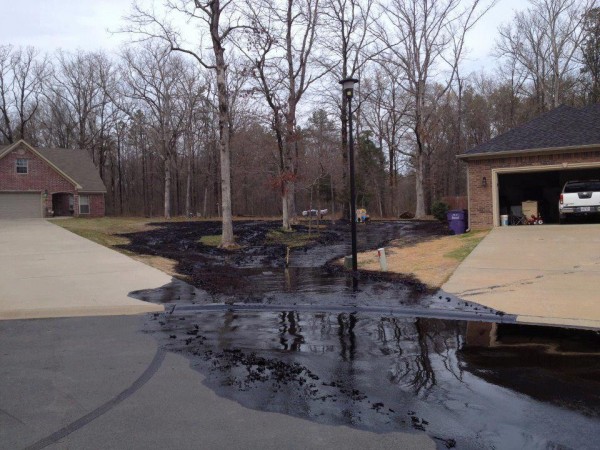
If President Obama rejects the permit for the Keystone XL pipeline, Big Oil executives are likely to look back at last weekend's tar sands spill in Mayflower, Arkansas as a key reason for their defeat.
In a rational world, President Obama would have rejected the Keystone XL pipeline long ago. The nation's top climate scientists have declared it an environmental disaster, over 800,000 Americans have written the Senate and State Department opposing the project, more than 40,000 recently descended on Washington, DC to push for a rejection. Time Magazine has called Keystone XL the "Selma and Stonewall" of the environmental movement for good reason: more people have gone to jail and rallied in the streets over the pipeline than any other environmental issue in the last decade.
But it's the images of tar sands oil submerging backyards, flowing down driveways, and contaminating entire streets of the Mayflower subdivision that may finally dramatize all the risks that come with Keystone XL. The ExxonMobil Pegasus pipeline that ruptured in Mayflower carried about 90,000 barrels of tar sands a day, about 1/10th of tar sands that would flow through Keystone XL. Take the Mayflower spill, times it by ten, and superimpose it over one of our largest sources of fresh drinking water, the Ogallala Aquifer, and you'll begin to get an idea of what a spill from Keystone XL would look like: a BP style disaster on land.

It was pictures like those coming out of Mayflower that helped fuel the last great surge of environmental activism in the late 1960s that led to the first Earth Day and the passage of the Clean Water Act and the Clean Air Act and the creation of the Environmental Protection Agency. Then, it was the Cuyahoga River catching on fire, the massive oil spill off of Santa Barbara, and other local disasters that brought the "pollution crisis" to public consciousness. Now, it's pictures of climate catastrophes like last summer's massive wildfires in Colorado or the devastation caused by Hurricane Sandy, and videos of fossil fuel disasters like the Mayflower spill or last year's tar sands spill in Kalamazoo River, that are causing people to connect the dots between the new extreme energy rush and the ever worsening climate crisis.

This April 18, the State Department will host its one public comment hearing in Nebraska on the latest supplemental environmental impact statement for the Keystone XL pipeline, a review that was widely criticized by environmental groups and experts as seriously flawed and inadequate. 350.org is working with our allies to submit over 1,000,000 public comments and our friends at BOLD Nebraska are helping organize hundreds of farmers, ranchers, and landowners who will testify in person. Their words (and yours if you submit a comment) will make a difference - the State Department is required by law to count and review every comment submitted. But perhaps it's the images out of places like Mayflower that will speak louder than all those words.
We've been given just a small glimpse of what our fossil fuel addicted future could look like: more spills, more climate disasters, more communities put at risk for industry profits. It's a future that we, and President Obama, can and should reject. It doesn't have to be this way. After all, as our friend Van Jones says, "You know what they call a solar spill? A sunny day."
